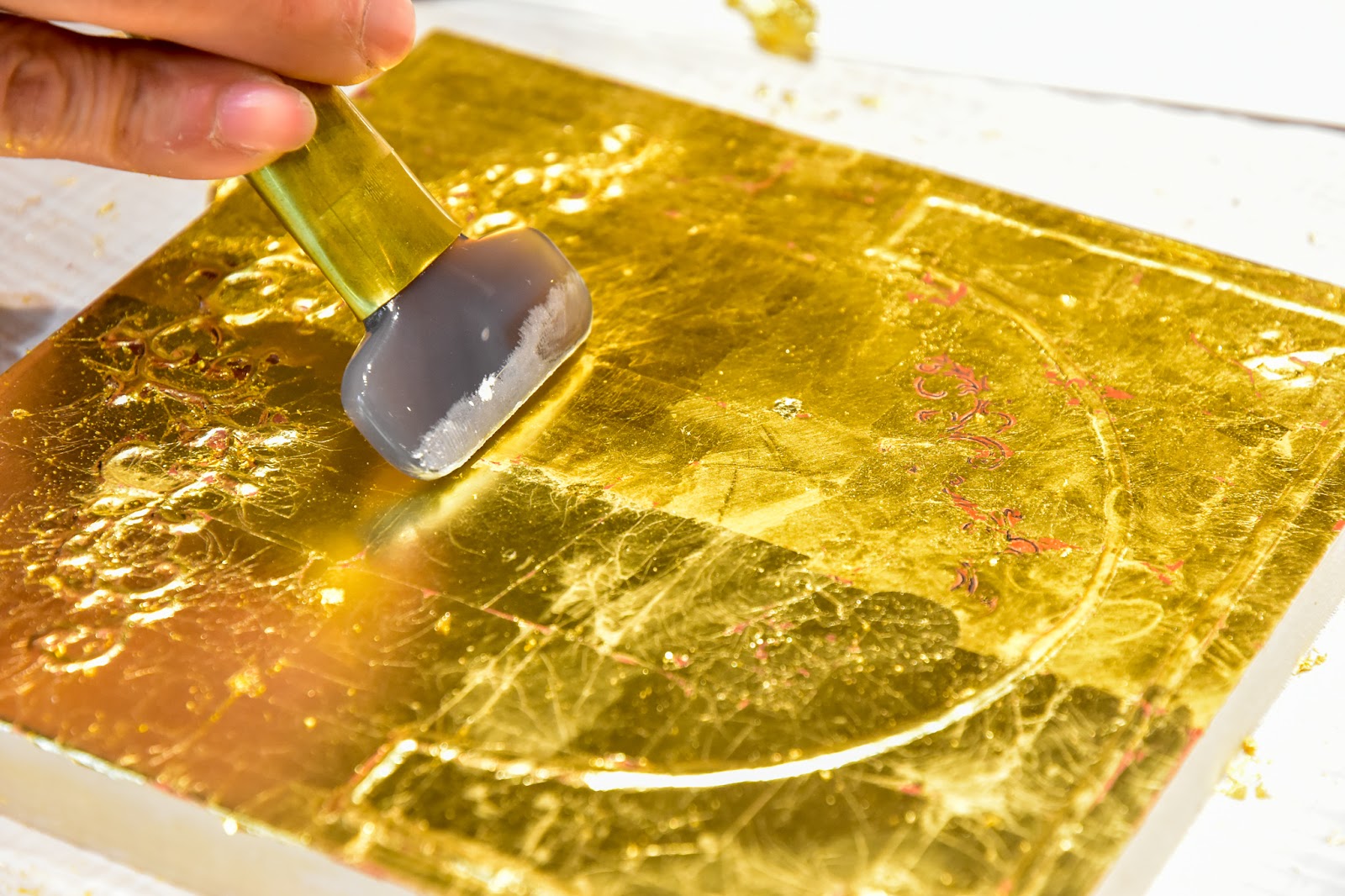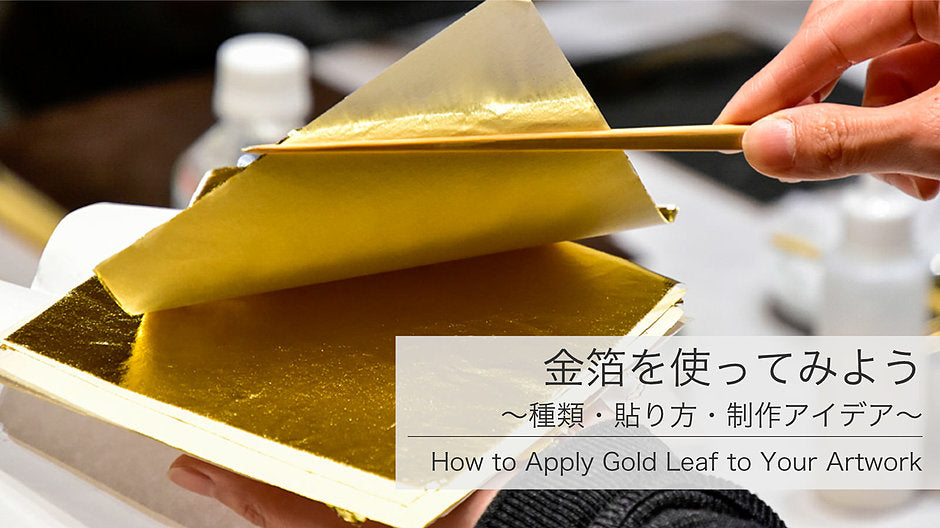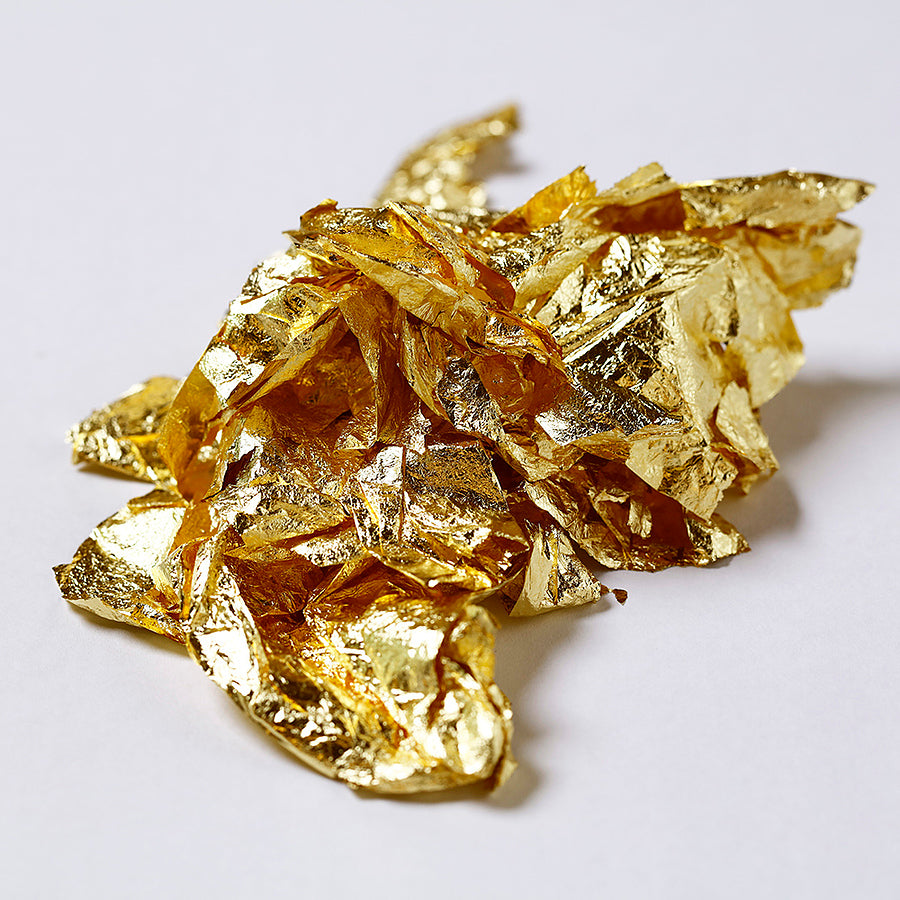ーWhat is a Metal Leaf?
A metal leaf is a thin sheet of metal used to decorate paintings and other objects.
Gold has become an object of beauty in many countries because of its processability, high luster, and excellent preservation properties, resulting in its adoption in various art styles.
In particular, gold leaf played a role similar to today's indirect lighting when people had to rely on natural light and flames as their interior light source.
In the case of Japanese art, our ancestors attempted to explore "how to create a bright space in the dark environment of a Japanese-style house. As a result, a variety of artworks using gold leaf has developed, including gold folding screens (Kinbyobu), gold lacquerware (Maki-e), and gold strip decoration (Kirikane).

Since the metal leaf is extremely thin and fragile, there are many different ways to use it, such as pasting it on a substrate, cutting it into any shape, or sprinkling it as powder.
ーTypes of Metal Leaf

Various metals such as gold, silver, copper, platinum, and aluminum are used for metal leaves. There is also a colorful metal leaf series called Colored Silver Leaf or Shinkohaku in Japanese which is made by coating silver leaf with synthetic resins and tinted with dyes or pigments.
PIGMENT TOKYO ONLINE SHOP「METAL LEAF」
Moreover, there are various types of gold leaves according to their colors and shapes.
・Pure Gold Leaf
Pure Gold Leaf Sanbu Tachikiri, Pure Gold Leaf Yongo (No.4) Tachikiri, Pure Gold Leaf Shogomo Tachikiri, Italian Pure Gold Leaf (23.75k)In general, the term "gold leaf" refers to these pure gold leaves. They bring out the rich luster unique to gold. Sanbu, Yongo, and Shogomo refer to the percentage of gold contained in the metal leaves. Tachikiri (Cut-off) indicates the manufacturing method used. Also, Italian gold leaf is thicker than Japanese gold leaf.
・Brass Leaf
Brass Leaf, Aokuchi (Bluish), Brass Leaf Akakuchi (Reddish)These metal leaves are called brass leaves or red copper leaves. Since they are made of copper and zinc which are less expensive than pure gold leaf. They are often used as a cheaper alternative to pure gold leaf.
・Metal Leaf Flakes (Kirimawashi)
Pure Gold Metal Leaf Yongo (No.4) KirimawashiThese metallic flakes are the leftovers of the metal leaf after cropping them into a small square shape. It is suitable for application in an area that does not require a whole sheet of a metal leaf or Sunago, a technique to sprinkle the powder of a metal leaf.
・Metal Leaf Powder (Kinkeshi)
Pure Gold Powder Shoichibu 0.4g, Pure Gold Powder Shogomo 0.4g, Pure Gold Powder Sanbushoku 0.4g
A fine-grained pure gold pigment. It is used in paintings, fine Buddhist altar ware, and Kintsugi (golden joinery). The paint finely ground and kneaded with animal glue is called Kin/Gin (gold/silver) Keshi or Kin/Gin (gold/silver) Dei.
The following articles also introduce the different types, focusing on colors.
Since ancient times, artists have used silver leaves to represent the glowing moon in the night sky. Find out more in the following article!
ーHow to Apply Metal Leaf

The following are the suggested tools for applying metal leaf:
・Adhesive / Glue
・Akautsushi-gami (Wax Paper)
・Palette Plate
・Flat brush
・Large Flat Brush
・Baby Powder
Like a paper-to-paper collage, the metal leaf needs an adhesive or glue to be pasted on a substrate. For beginners, we recommend Gilding Size (Missione all'Acqua), a water-based metal leaf adhesive. Since this product can be used straight out of the bottle, making it is easy to use and experience.
One of our original products, Fish Glue for Sizing 20%, can also be used as a medium for metal leaf application. When you use this product, it is better to add some Alginate Liquid 1% to the mixture. The alginate liquid gives viscosity to the fish glue and can slow down its drying speed.
You may watch the following instructional video for more information.
I also recommend this art set "Introduction to Pure Gold Leaf."
*Sorry, this item is no longer available.
ーApply Metal Leaf Powder with a Sunagozutsu

A Sunagozutsu (bamboo sieve) can create metal leaf powder on a substrate.
The word "Sunago" in Sunagozutsu means a powdered form of a metal leaf.
It is often used to decorate calligraphy paper such as Kyokan (a sutra scroll) and Shikishi (a square piece of fancy paper) and is also used in paintings to express light on the ground or in a haze.
Like the previous technique of applying metal leaf, this requires an adhesive too, so please use diluted fish glue. The roughness of flakes is according to the coarseness of the mesh of the Sunagozutsu, with "Kindei (Fine powdery)" being the finest and "Gokuara (Extra coarse)" the coarsest.
You can also put a sheet of the metal leaf directly into a Sunagozutsu and sprinkle it, or you can use Kirimawashi, the leftovers of the metal leaf that is commonly used for this method. Moreover, you may also collect the small pieces of metal leaf left over from your metal leaf application and use them as Kirimawashi.
Check the following article to read more about applying metal leaves.
Check the following article to read more about applying metal leaves.
ーLet’s Create Shapes You Like
Just like when collaging paper, you can cut the metal leaf and arrange it into the shape you want. If the metal leaf is sandwiched between sheets of Washi paper, it can be cut freely with scissors or a cutter, on the other hand, a bamboo knife or a Western-style gilding knife is commonly used for cutting it directly.
Moreover, a Shikagawadai (deerskin) Gilding Board or a Western-style Gilder’s Leather Cushion Pad is a must-have item to work smoothly. An animal skin cover will prevent the metal leaf from sticking to the board.
<br

Moreover, using a template like silk screens makes it possible to transfer a detailed pattern with a metal leaf onto paper.

ーPolishing Metal leaf with an Agate Burnisher

The gilded surface will become shinier and more brilliant by polishing the metal leaf. In Europe, agate is used to polish metal leaves. While in Japan, sea bream’s tooth or boar tusks are used occasionally.
More detailed instructions about using an agate burnisher are in this article below.
ーGilding in Modern Times

The usage of metal leaves is still developing today.
A metal leaf manufacturer in Hiroshima prefecture, Japan, Rekiseisha Co., Ltd. has developed its own metal leaf, which is used not only for artworks but also for interior decorations, such as the entrances of foreign-affiliated hotels.
Moreover, one of our best sellers, the "Leaf Gift" is a pack filled with metal leaf paper carefully selected by craftsmen.
Color Titanium TranTixxi, developed and produced by Nippon Steel Corporation, a major steel manufacturer, is another cutting-edge product that carries on the spirit of metal leaf.
The company's proprietary technology allows it to freely control the oxide film on the titanium surface to create a variety of colors. Moreover, it is resistant to discoloration even in acid rain, ultraviolet rays, and seawater so it has been used for building exteriors.
PIGMENT TOKYO carries color titanium panels for paintings that are applied to the design and technique of titanium TranTixxi. You can paint on these panels with acrylic and oil paints and even apply the metal leaves.
ーConclusion
Some people may feel that using metal leaves is a bit of a challenge.
However, PIGMENT TOKYO offers a wide range of products, from easy-to-use beginner kits to tutorial videos.
In the "Introduction to Metal Leaf Workshop," which is held regularly in our store, participants can learn traditional metal leaf techniques such as "Hiraoshi," "Kirihaku," and "Sunago" which are gilding, cutting, and powdering techniques introduced in this article.
WORKSHOP–PIGMENT TOKYO

Our knowledge is not limited to metal leaf, PIGMENT TOKYO is sharing information about art material through workshops and articles. Therefore, feel free to sign up for our membership to keep posted on new events and updates!
Translated by Atsumi Okano and Nelson Hor Ee Herng
PIGMENT TOKYO Art Materials Experts













